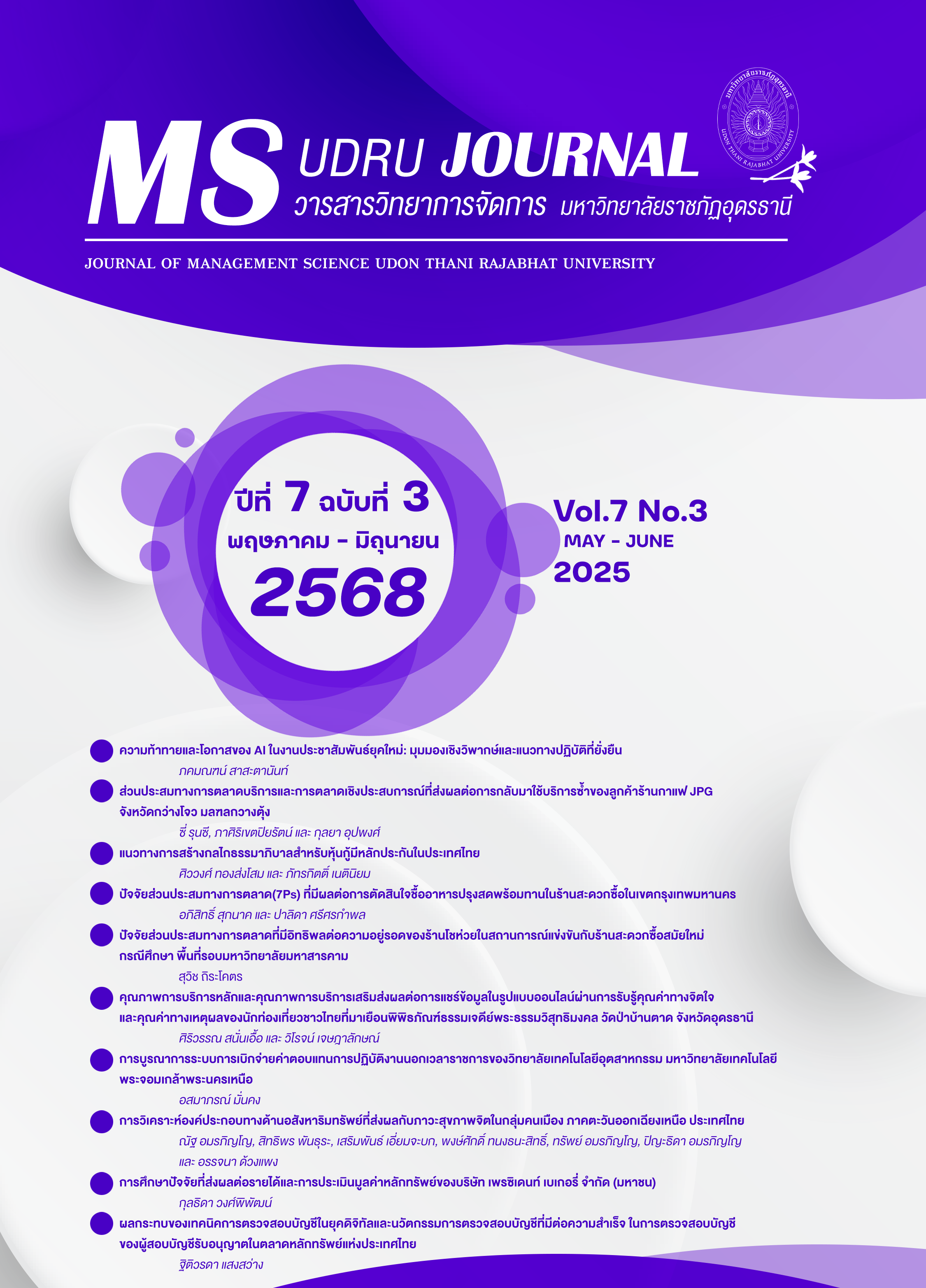คุณภาพการบริการหลักและคุณภาพการบริการเสริมส่งผลต่อการแชร์ข้อมูลในรูปแบบออนไลน์ ผ่านการรับรู้คุณค่าทางจิตใจและคุณค่าทางเหตุผลของนักท่องเที่ยวชาวไทยที่มาเยือนพิพิธภัณฑ์ ธรรมเจดีย์พระธรรมวิสุทธิมงคล วัดป่าบ้านตาด จังหวัดอุดรธานี
Main Article Content
บทคัดย่อ
การวิจัยครั้งนี้มีวัตถุประสงค์เพื่อศึกษา คุณภาพการบริการหลักและคุณภาพการบริการเสริมส่งผลต่อการแชร์ข้อมูลในรูปแบบออนไลน์ ผ่านการรับรู้คุณค่าทางจิตใจและคุณค่าทางเหตุผล ของนักท่องเที่ยวชาวไทยที่มาเยือนพิพิธภัณฑ์ธรรมเจดีย์พระธรรมวิสุทธิมงคล วัดป่าบ้านตาด จังหวัดอุดรธานี เป็นงานวิจัยเชิงปริมาณมีเครื่องมือวิจัยคือ แบบสอบถาม โดยกลุ่มตัวอย่างเป็นนักท่องเที่ยวชาวไทยที่มาเยือนพิพิธภัณฑ์ธรรมเจดีย์พระธรรมวิสุทธิมงคล วัดป่าบ้านตาด จังหวัดอุดรธานี จำนวน 138 คน การวิเคราะห์ข้อมูลเป็นการใช้สถิติเชิงพรรณนา การวิเคราะห์สัมประสิทธ์ของเพียร์สัน และการวิเคราะห์การถดถอยเชิงพหุคูณ ผลการศึกษาพบว่า ส่วนใหญ่เป็นเพศหญิง มีจำนวน 113 คน มีอายุเฉลี่ย 20-30 ปี จำนวน 65 คน อาชีพพบว่าส่วนใหญ่เป็น นักเรียน/นักศึกษา มีจำนวน 76 คน จำนวนครั้งที่มาเยี่ยมส่วนใหญ่มาครั้งแรกอยู่ที่ 74 คน และแหล่งข้อมูลที่ได้รับเกี่ยวกับพิพิธภัณฑ์ ส่วนมากคือ คนรู้จักแนะนำ อยู่ที่ 98 คน ระดับตัวแปรทั้งหมดภาพรวมมีค่าเฉลี่ยระดับมากที่สุด และผลการทดสอบสมมุติฐานได้มีการยอมรับสมมุติฐานทั้ง 6 สมมุติฐาน โดยสมมุติฐานที่ 1 คุณภาพการบริการหลักส่งผลเชิงบวกต่อการรับรู้คุณค่าทางจิตใจ สมมุติฐานที่ 2 คุณภาพการบริการหลักส่งผลเชิงบวกต่อการรับรู้คุณค่าทางเหตุผล สมมุติฐานที่ 3 คุณภาพการบริการเสริมส่งผลเชิงบวกต่อการรับรู้คุณค่าทางจิตใจ สมมุติฐานที่ 4 คุณภาพการบริการเสริมส่งผลเชิงบวกต่อการรับรู้คุณค่าทางเหตุผล สมมุติฐานที่ 5 การรับรู้คุณค่าทางจิตใจส่งผลเชิงบวกต่อการรับรู้คุณค่าทางเหตุผล และ สมมุติฐานที่ 6 การรับรู้คุณค่าทางเหตุผลส่งผลเชิงบวกต่อการแชร์ข้อมูลในรูปแบบออนไลน์ ผลการศึกษานี้สามารถเป็นข้อมูลให้ฝ่ายผู้บริหารทางการตลาดนำไปพัฒนา ด้านกลยุทธ์การตลาดเพื่อรองรับนักท่องเที่ยวในอนาคต
Article Details

อนุญาตภายใต้เงื่อนไข Creative Commons Attribution-NonCommercial-NoDerivatives 4.0 International License.
บทความที่ได้รับการตีพิมพ์เป็นลิขสิทธิ์ของคณะวิทยาการจัดการ มหาวิทยาลัยราชภัฏอุดรธานี
ข้อความที่ปรากฏในบทความแต่ละเรื่องในวารสารวิชาการเล่มนี้
ไม่ใช่ความคิดเห็นและความรับผิดชอบของผู้จัดทำ บรรณาธิการ กองบรรณาธิการ และคณะวิทยาการจัดการ มหาวิทยาลัยราชภัฏอุดรธานี ความรับผิดชอบด้านเนื้อหาและการตรวจร่างบทความแต่ละเรื่องเป็นความคิดเห็นของผู้เขียนบทความแต่ละท่าน
เอกสารอ้างอิง
ชุติมา แก่นจันทร์. (2562). อิทธิพลของคุณภาพการให้บริการ การรับรู้คุณค่า และภาพลักษณ์ต่อ ความเต็มใจที่จะจ่ายต่อสินค้าและบริการผ่านความพึงพอใจของลูกค้าของธนาคารออมสิน. วิทยานิพนธ์บริหารธุรกิจมหาบัณฑิต, มหาวิทยาลัยศิลปากร.
ธนวัฒน์ กันภัย และ เบญจพร ประจง. (2563). การรับรู้คุณค่าสุนทรียภาพทางศิลปะและการตระหนักถึงความสำคัญของชุมชนริมน้ำจันทบูรณ์ผ่านประสบการณ์การรับรู้ของคนในชุมชน และนักท่องเที่ยวในฐานะแหล่งท่องเที่ยวสำคัญของจังหวัดจันทบุรี. วารสารมนุษยศาสตร์และสังคมศาสตร์ มหาวิทยาลัยนครพนม, 10(2), 74-81.
ธานินทร์ ศิลป์จารุ. (2563). การวิจัยและวิเคราะห์ข้อมูลสถิติด้วย SPSS และ AMOS. (พิมพ์ครั้งที่ 18). กรุงเทพฯ: บิสซิเนสอาร์แอนด์ดี.
ธธีร์ธร ธีรขวัญโรจน์และสุพจน์ กฤษฎาธาร. (2563). การตลาดบริการ (พิมพ์ครั้งที่ 12). กรุงเทพฯ: ซีเอ็ดยูเคชัน.
นิติพงศ์ มานะพงศ. (2561). การรับรู้คุณภาพการบริการ การรับรู้การส่งเสริมการขาย การรับรู้ภาพลักษณ์ทางสังคม การรับรู้ค่านิยมทางสังคม ส่งผลต่อการตัดสินใจใช้บริการสายการบินต้นทุนต่างของไทยเพื่อเดินทางไปประเทศญี่ปุ่น. วิทยานิพนธ์บริหารธุรกิจมหาบัณฑิต, มหาวิทยาลัยกรุงเทพ.
พิพิธภัณฑ์ธรรมะเจดีย์. (2565). พิพิธภัณฑ์ธรรมเจดีย์พระธรรมวิสุทธิมงคล (หลวงตาพระมหาบัวญาณสัมปันโน). สืบค้นเมื่อ 1 พ.ย. 2565 จาก, https://web.facebook.com/dhammachedi/?_rdc=1&_rdr.
อนันต์ เชี่ยวชาญกิจการ. (2561). โมเดลความสัมพันธ์เชิงสาเหตุของการรับรู้การด้านเนินงานบริการ ด้านคุณภาพ บริการคุณค่าบริการ ปฏิสัมพันธ์การบริการ ต่อความพึงพอใจและความตั้งใจ เชิงพฤติกรรมของลูกค้าที่มาใช้บริการสปา ในอำเภอหัวหิน จังหวัดประจวบคีรีขันธ์. วารสารมนุษยศาสตร์และสังคมศาสตร์นายเรืออากาศ, 6, 63-79.
เอมมิกา ปานอุทัย และกัมปนาท สิริโยธา. (2563). การรับรู้คุณค่าของผู้บริโภคและคุณภาพการบริการ ที่มีต่อความมีชื่อเสียงของตราสินค้ากรณีศึกษาร้านอาหารญี่ปุ่นระดับพรีเมียมในเขต เทศบาลเมืองขอนแก่น จังหวัดขอนแก่น. สืบค้นเมื่อ 2 พฤศจิกายน 2565 จาก, https://incbaa.kku.ac.th/img/files/articles/3fedf-29.e1-132.pdf.
อัมพล ชูสนุก มิลินลดา กุลนายุ และคณะ 2559). อิทธิพลของคุณภาพ การให้บริการ การรับรู้คุณค่า และภาพลักษณ์ ต่อความเต็มใจที่จะจ่ายต่อสินค้าและ บริการผ่านความพึงพอใจของลูกค้าของธนาคารออมสิน เขตภาคตะวันตก. วารสารมนุษยศาสตร์สังคมศาสตร์ และศิลปะ มหาวิทยาลัยศิลปากร, 9(1), 1565-1584.
Chei Sian Lee and Long Ma. (2012). News sharing in social media: The effect of gratifications and prior experience, Journal of Computer in Human Behavior, 28 (2), 331-339. https://doi.org/10.1016/j.chb.2011.10.002.
Coudounaris, D. N., & Sthapit, E. (2017). Antecedents of memorable tourism experience related to behavioral intentions. Psychology & Marketing, 34(12), 1084-1093. https://doi.org/10.1002/mar.21048.
Faul, F., Erdfelder, E., Lang, A.-G., & Buchner, A. (2007). G*Power 3: A flexible statistical power analysis program for the social, behavioral, and biomedical sciences. Behavior Research Methods, 39, 175-191.
Faul, F., Erdfelder, E., Buchner, A., & Lang, A.-G. (2009). Statistical power analyses using G*Power 3.1: Tests for correlation and regression analyses. Behavior Research Methods, 41, 1149-1160.
Fletcher, A., & Lee, M. J. (2012). Current social media uses and evaluations in American museums. Museum Management and Curatorship, 27(5), 505-521. https://doi.org/10.1080/09647775.2012.738136.
Gilmore, A. and Rentschler, R. (2002). Changes in Museum Management: A Custodial or Marketing Emphasis. Journal of Management Development, 20(10), 745-760.
Harrison, P., and R. Shaw. (2004). Consumer satisfaction and post-purchase intentions: An exploratory study of museum visitors. International Journal of Arts Management 6(2), 23–32.
Harahap, K. A. E. (2014). Analisis pengaruh kualitas pelayanan, harga, dan promosi terhadap kepuasan pengunjung di Museum Ronggowarsito Semarang (Skripsi). Fakultas Ekonomi & Bisnis.
Harvey, D. (2013). Human resource management: An experimental approach (2nd ed.). New Jersey: Prentice-Hall.
Lopes, Dominic Mc Iver (2003). Pictures and the representational mind. Monist, 86(4), 632–651.
Holbrook, M. B. (1999). Consumer value: A framework for analysis and research.
Ladislav Kesner. (2006). The role of cognitive competence in the art museum experience. Chicago,34 (6), 4-19.
Lovelock, C.H. (1983). Classifying services to gain strategic marketing insights, Journal of Marketing, 47(3), 9-20.
Moliner, M.A., Sánchez, J., Rodríguez, R.M. and Callarisa, L. (2007). Perceived relationship quality and post‐purchase perceived value: An integrative framework, European Journal of Marketing, 41(11/12), 1392-1422. https://doi.org/10.1108/03090560710821233.
Ninlaput, R. (2018). Service Quality and SatisfactionRelated to Customer’s Repurchase at PaoloRangsit Hospital Service (Research Report). Pathum Thani: Rajamangala University of Technology Thanyaburi.
Parasuraman, A., Zeithaml, V. a., and Berry, L. L. (1990). Delivering Quality Service: Balancing Customer perceptions and expectation. London: The Free Press.
Phaswana-Mafuya, N. and Haydam, N. (2005). Tourists’ expectations and perceptions of the Robben Island Museum – a world heritage site, Museum Management and Curatorship, 20(2), 149- 169.
Rentschler, R. & Gilmore, A. (2002). Museums: discovering services marketing. International Journal of Arts Management, 5(1), 62-72.
Rofianto, W. Wijayanto, D. Nugraha, A.I. (2017). Motivation for Sharing Online Video Advertisement: Integrating Identity Theory and the Expanded Advertising Model. Retrieved November 2, 2022, from https://www.semanticscholar.org/search?q=Motivation%20for%20Sharing%20Online%20Video%20Advertisement%20Integrating%20Identity%20Theory%20and%20the%20Expanded%20Advertising%20Model&sort=relevance.
Rollins, Mark (2003). The mind in pictures: Perceptual strategies and the interpretation of visual art. Monist, 86(4), 608– 631.
Solomon, M. R. (1990). Consumer Behavior. New Jersey: Prentice-Hall.
Sheth, J. N., Newman, B. I., & Gross, B. L. (1991). Why we buy what we buy: A theory of consumption values. Journal of Business Research, 22(2), 159-170.
Sweeney, J. C., & Soutar, G. N. (2001). Consumer perceived value: The development of a multiple item scale. Journal of Retailing, 77(2), 203-220.
Vesna, Z, Maja, M.B., & Tanja, D. (2010). Modelling perceived quality, visitor satisfaction and behavioural intentions at the destination level, Journal of Tourism management, 31 (4), 537-546. https://doi.org/10.1016/j.tourman.2009.06.005.
Voss, G.B., Parasuraman, A. and Grewal, D. (1998). The role of price, performance, and expectations in determining satisfaction in service exchanges. Journal of Marketing, 62(4), 46-62.
Zameer, H., Tara, A., Kausar, U. and Mohsin, A. (2015). Impact of service quality, corporate image and customer satisfaction towards customers’ perceived value in the banking sector in Pakistan, International Journal of Bank Marketing, 33(4), 442-456. https://doi.org/10.1108/IJBM-01-2014-0015.
Zeithaml, V.A. (1988). Consumer perceptions of price, quality and value: A meansend model and synthesis of evidence. Journal of Marketing, 52(3), 2-22.


